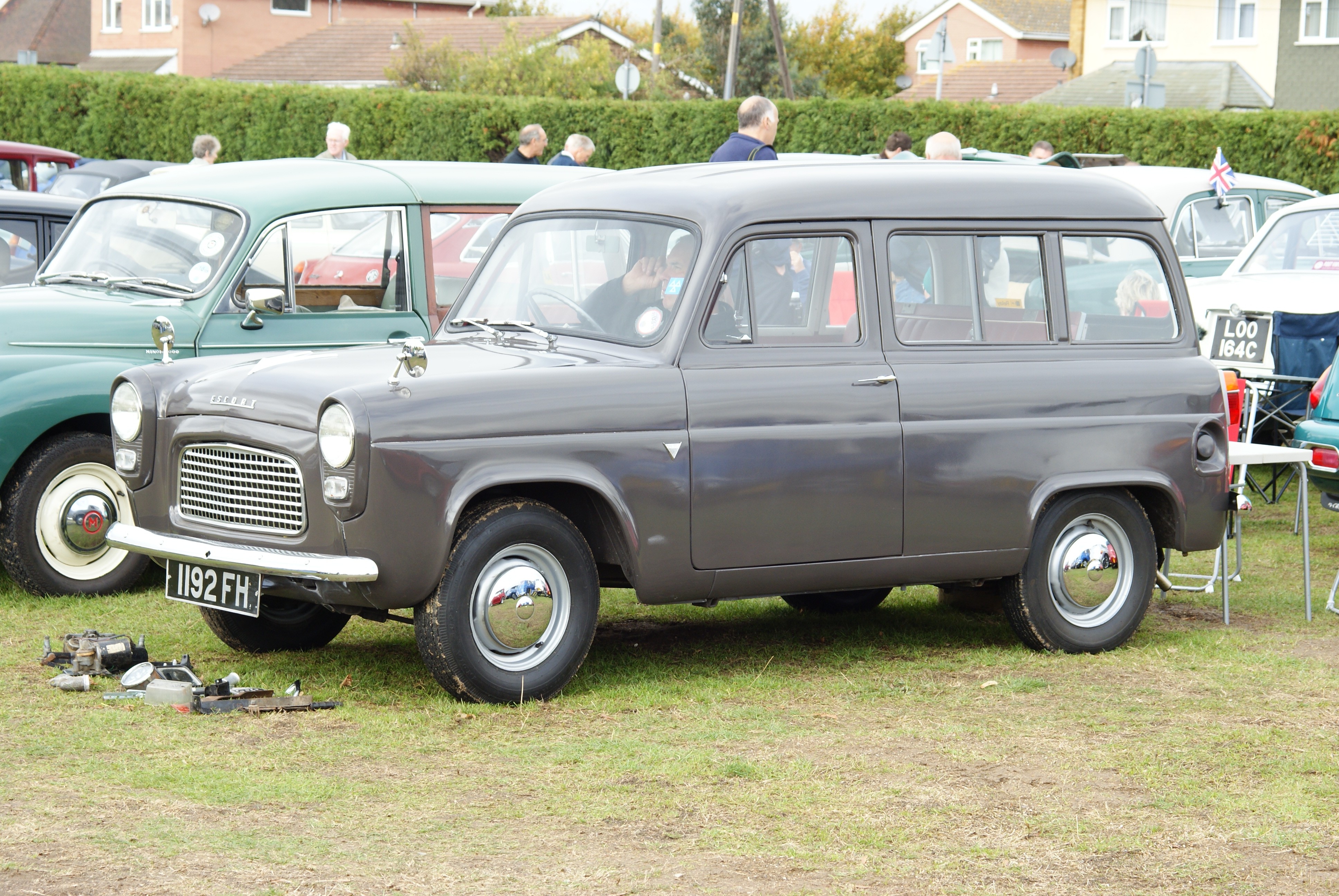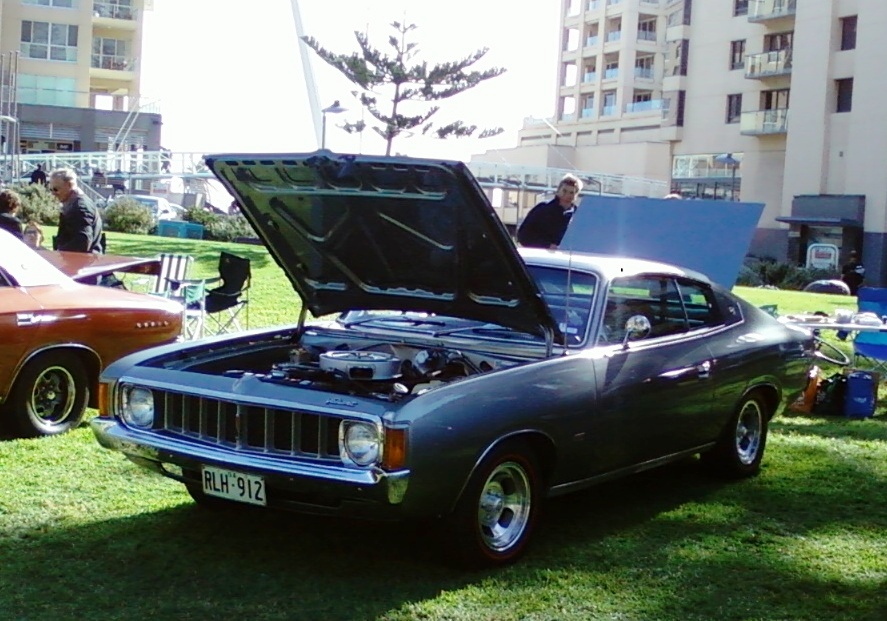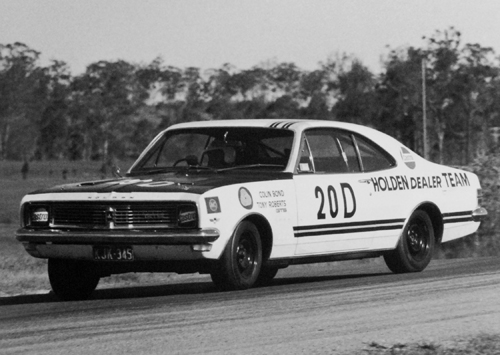|
1972 Sandown 250
The 1972 Sandown 250 was an endurance motor race for Group E Series Production Touring Cars.Eligibility for the 1972 Australian Manufacturers' Championship was restricted to Group E Series Production Touring Cars, as outlined in Australian Title Conditions, 1972 CAMS Manual of Motor Sport, page 89 It was held on 10 September 1972 over 130 laps of the Sandown circuit in Victoria, Australia, a total distance of 250 miles (403 km).Tom Naughton, Ford Bounces Back, Racing Car News, October 1972, pages 68-69 The race was Heat 2 of the 1972 Australian Manufacturers' Championship. The race was own by John Goss driving a Ford XY Falcon GTHO Phase III. Class Structure As a heat of the 1972 Australian Manufacturers' Championship, the race featured four classes defined by "Capacity Price Units".Official Programme, Adelaide International Raceway, 27 August 1972 The CP Unit value for each car was assessed by multiplying the engine capacity (in litres) by the Sydney retail price (in Austr ... [...More Info...] [...Related Items...] OR: [Wikipedia] [Google] [Baidu] |
Group E Series Production Touring Cars
Group E Series Production Touring Cars was an Australian motor racing category for production based sedans competing with limited modifications. It was current from 1964 to 1972. Although production car racing in Australia had gained momentum with the running of the first Armstrong 500 endurance race at Phillip Island in 1960, no national guidelines for this type of racing existed until 1 January 1964 when the Group E regulations were introduced by the Confederation of Australian Motor Sport as part of a major review of Australian motor sport categories. Vehicles racing in Group E had to be one of at least 1000 units which had been produced in 12 months and could compete only with strictly limited modifications. The rules were framed to cater for cars such as those that had been contesting the Armstrong 500 (which had moved from Phillip Island to the Mount Panorama Circuit at Bathurst in 1963), although that race continued to run under its own regulations which at the time limited t ... [...More Info...] [...Related Items...] OR: [Wikipedia] [Google] [Baidu] |
Ford Escort Twin Cam
The Ford Escort is a small family car that was manufactured by Ford of Europe from 1968 until 2000. In total there were six generations, spread across three basic platforms beginning with the original rear-wheel drive Mk.1/Mk.2 (1968–1980), the "Erika" front wheel drive Mk.3/Mk.4 (1980–1990), and the final CE-14 Mk.5/Mk.6 (1990–2002) version. Its successor - the Ford Focus - was released in 1998, but the final generation of Escort was gradually phased out, with the panel van version ending production in 2002 in favour of the Ford Transit Connect. The Escort was frequently the best selling car in Britain during the 1980s and 1990s. A total of more than 4.1 million Escorts of all generations were sold there over a period of 33 years. In 2014, Ford revived the Escort name for a car based on the second-generation Ford Focus sold on the Chinese market. Naming Convention Whilst the Escort designation existed three basic platforms (and officially, the canon does not includ ... [...More Info...] [...Related Items...] OR: [Wikipedia] [Google] [Baidu] |
Sandown 500
The Sandown 500 (formally known as the Penrite Oil Sandown 500) is an annual endurance motor race which is staged at the Sandown Raceway, near Melbourne, Victoria, Australia from 1964. The event's name, distance – and the category of cars competing in it – has varied widely throughout its history. Most recently, the event was held as a championship event for Supercars from 2003 to 2007 and from 2012 to 2019. Historically the event was held in September, the month before Australia's premier endurance race, the Bathurst 1000. However in its final running to date in 2019, it was held in November. The event will return in 2023 after a three-year hiatus in September. History Production car era The first two races were open to production based sedans and, at six hours duration, were substantially longer than later iterations of the race. Both races were won by an Alfa Romeo Giulia entered by Alec Mildren Racing. In 1965, Sandown also hosted the single-event Australian Touring Ca ... [...More Info...] [...Related Items...] OR: [Wikipedia] [Google] [Baidu] |
Allan Moffat
Allan George Moffat OBE (born 10 November 1939 in Saskatoon, Saskatchewan, Canada) is a Canadian-Australian racing driver known for his four championships in the Australian Touring Car Championship, six wins in the Sandown 500 and his four wins in the Bathurst 500/1000. Moffat was inducted into the V8 Supercars Hall of Fame in 1999. Moffat and his long-time friend and rival (and later co-driver) Peter Brock are the only drivers to have won The Great Race at Bathurst in both its 500-mile and 1000-kilometre formats. In October 2018, he was inducted into the Sport Australia Hall of Fame. Racing career Born in Saskatoon, Saskatchewan, Moffat moved to Australia as a 17-year-old college student with his parents when his father, who worked for Massey Ferguson, was transferred to Melbourne for work and in the early 1960s embarked on his record-setting motor racing career. He started his racing career at the wheel of a Triumph TR3. 1964 to 1971 Allan Moffat and Jon Leighton drove ... [...More Info...] [...Related Items...] OR: [Wikipedia] [Google] [Baidu] |
John French (racing Driver)
John French (born 28 November 1930) is an Australian retired racing driver. French was born in Millaa Millaa, Queensland, and his long career lasted from the 1960s to the early 1980s. He won the 1962 Australian GT Championship driving a Centaur-Waggott and in 1969 French paired with Allan Moffat to win the Sandown Three Hour race in a Ford Falcon GTHO Phase I. French was well known multi-franchise car dealer selling BMC vehicles, Alfa Romeo, Renault, Peugeot and Subaru in Brisbane. Many of the marques he sold featured prominently in his professional racing career. Nationally however he is best remembered as Dick Johnson's co-driver to win the crash-shortened 1981 Bathurst 1000 (French was driving the #17 Ford XD Falcon when the race was stopped, but wasn't one of the cars in the accident). He regularly drove the works Ford Falcon GTHO's alongside Allan Moffat, and also drove Moffat's and Ian Geoghegan's Improved Production Ford Falcon GTHOs in the Australian Touring Car ... [...More Info...] [...Related Items...] OR: [Wikipedia] [Google] [Baidu] |
Chrysler VH Valiant Charger
The Chrysler Valiant Charger was a two-door hardtop coupe introduced by Chrysler Australia in 1971. It was a short wheelbase version of the concurrent Australian Chrysler Valiant sedan. Introduced within the VH Valiant series, it continued as a variant through the subsequent VJ, VK and CL series, until production ceased in 1978. It was marketed and badged as the Valiant Charger in the VH and VJ series and as the Chrysler Charger in the later VK and CL series. While still based on the US Chrysler A-body platform, with virtually identical front suspension, the fenders were widened, and a wider rear axle fitted, so that the track, front and rear, was considerably wider than any US A-body, this also allowed wheels much wider than a US A-body. The Australian Chargers also used a 5-on-4.5" wheel bolt circle (still 7/16" studs), while the US cars did not go to "big bolt pattern" until 1973. The Charger was extraordinarily popular in Australia during the VH series. At one point Charger p ... [...More Info...] [...Related Items...] OR: [Wikipedia] [Google] [Baidu] |
Ford Motor Company Of Australia Ltd
Ford commonly refers to: * Ford Motor Company, an automobile manufacturer founded by Henry Ford * Ford (crossing), a shallow crossing on a river Ford may also refer to: Ford Motor Company * Henry Ford, founder of the Ford Motor Company * Ford Foundation, established by Henry and Edsel * Ford Australia * Ford Brasil * Changan Ford * Ford Motor Company of Canada, Canadian subsidiary * Ford of Britain * Ford of Europe, the successor of British, German and Irish subsidiaries * Ford Germany * Ford Lio Ho * Ford New Zealand * Ford Motor Company Philippines * Ford Romania * Ford SAF, the French subsidiary between 1916 and 1954 * Ford Motor Company of South Africa * Fordson, the tractor and truck manufacturing arm of the Ford Motor Company * Ford Vietnam * Ford World Rally Team (aka Ford Motor Co. Team prior to 2005), Ford Motor Company's full factory World Rally Championship team (1978–2012) * Ford Performance * Henry Ford & Son Ltd, Ireland * List of Ford vehicles, models referred to ... [...More Info...] [...Related Items...] OR: [Wikipedia] [Google] [Baidu] |
Peter Brock
Peter Geoffrey Brock (26 February 1945 – 8 September 2006), known as "Peter Perfect", "The King of the Mountain", or simply "Brocky", was an Australian motor racing driver. Brock was most often associated with Holden for almost 40 years, although he raced vehicles of other manufacturers including BMW, Ford, Volvo, Porsche and Peugeot. He won the Bathurst 1000 endurance race nine times, the Sandown 500 touring car race nine times, the Australian Touring Car Championship three times, the Bathurst 24 Hour once and was inducted into the V8 Supercars Hall of Fame in 2001. Brock's business activities included the Holden Dealer Team (HDT) that produced Brock's racing machines as well as a number of modified high-performance road versions of his racing cars. Early years Peter Brock was born at the Epworth Hospital, Richmond, Victoria, the son of Geoff and Ruth Brock (née Laidlay). The family lived in the country town of Hurstbridge (now an outer suburb of Melbourne) and Brock con ... [...More Info...] [...Related Items...] OR: [Wikipedia] [Google] [Baidu] |
Holden Dealer Team
The Holden Dealer Team (HDT) was Holden's semi-official racing team from 1969 until 1986, primarily contesting Australian Touring Car events but also rallying, rallycross and Sports Sedan races during the 1970s. From 1980 the Holden Dealer Team, by then under the ownership of Peter Brock, diversified into producing modified road-going Commodores and other Holden cars for selected dealers via HDT Special Vehicles. After Holden terminated its association with Brock's businesses in February 1987, the team became the factory BMW team racing M3s race team in 1988. Further into 1988, Brock sold off his HDT Special Vehicles road car business, which has nevertheless, under various ownership, continued to modify Holden vehicles to this current day. The Firth years After showing an increasing interest in motorsport during the 1960s, Holden decided to form a team to enter both Touring Car and Rally events in 1969. However, Holden's parent company, General Motors forbade its manufa ... [...More Info...] [...Related Items...] OR: [Wikipedia] [Google] [Baidu] |
Colin Bond
Colin John Bond (born 24 February 1942) is a retired Australian racing driver. Bond reached the highest levels in Australian motorsport in 1969 when he was recruited by Harry Firth to the newly formed Holden Dealer Team. He quickly found success, winning the 1969 Hardie-Ferodo 500 mile race (now the Bathurst 1000) at Bathurst, New South Wales in a Holden Monaro. Bond was a particularly versatile driver, also finding success in the Australian Rally Championship, winning the title in 1971, 1972 and 1974 driving a Holden Torana. Bond also won the 1975 Australian Touring Car Championship in a Holden Torana and was inducted into the V8 Supercars Hall of Fame in 2002. Early career Bond initially made a reputation as a hillclimber with three NSW Hillclimb titles in 1965-67 driving a Lynx-Peugeot S/C. Also known as a rally driver he was relatively unknown in circuit racing circles apart from a few forays racing various Isuzu Belletts, when he was chosen to partner Tony Robert ... [...More Info...] [...Related Items...] OR: [Wikipedia] [Google] [Baidu] |
Mazda Capella
The Mazda Capella, also known as the 626 in North America and Southeast Asia, is a mid-size car that was manufactured by Mazda from 1970 until 2002. Sold in the Japanese domestic market under the Capella name, the vehicle was also commonly known in other major markets as the Mazda 626. Ford, Mazda's partner at the time, also used the Capella platform to create the Ford Telstar and Ford Probe. 4,345,279 of the 626 and Telstar models were sold worldwide. Designed to compete against Japanese mid-size stalwarts such as the Honda Accord, Toyota Corona, and Nissan Bluebird, the Capella was succeeded by the Mazda6 (Atenza) in 2002. The car was named after Capella, the brightest star in the constellation Auriga, the sixth-brightest in the night sky and the third-brightest in the northern celestial hemisphere, after Arcturus and Vega. __TOC__ First generation (1970–1978) The first Capella was introduced in May 1970 and lasted until 1978, and was introduced as an intermediate alt ... [...More Info...] [...Related Items...] OR: [Wikipedia] [Google] [Baidu] |
Ford Escort GT1600
The Ford Escort is a small family car that was manufactured by Ford of Europe from 1968 until 2000. In total there were six generations, spread across three basic platforms beginning with the original rear-wheel drive Mk.1/Mk.2 (1968–1980), the "Erika" front wheel drive Mk.3/Mk.4 (1980–1990), and the final CE-14 Mk.5/Mk.6 (1990–2002) version. Its successor - the Ford Focus - was released in 1998, but the final generation of Escort was gradually phased out, with the panel van version ending production in 2002 in favour of the Ford Transit Connect. The Escort was frequently the best selling car in Britain during the 1980s and 1990s. A total of more than 4.1 million Escorts of all generations were sold there over a period of 33 years. In 2014, Ford revived the Escort name for a car based on the second-generation Ford Focus sold on the Chinese market. Naming Convention Whilst the Escort designation existed three basic platforms (and officially, the canon does not includ ... [...More Info...] [...Related Items...] OR: [Wikipedia] [Google] [Baidu] |






